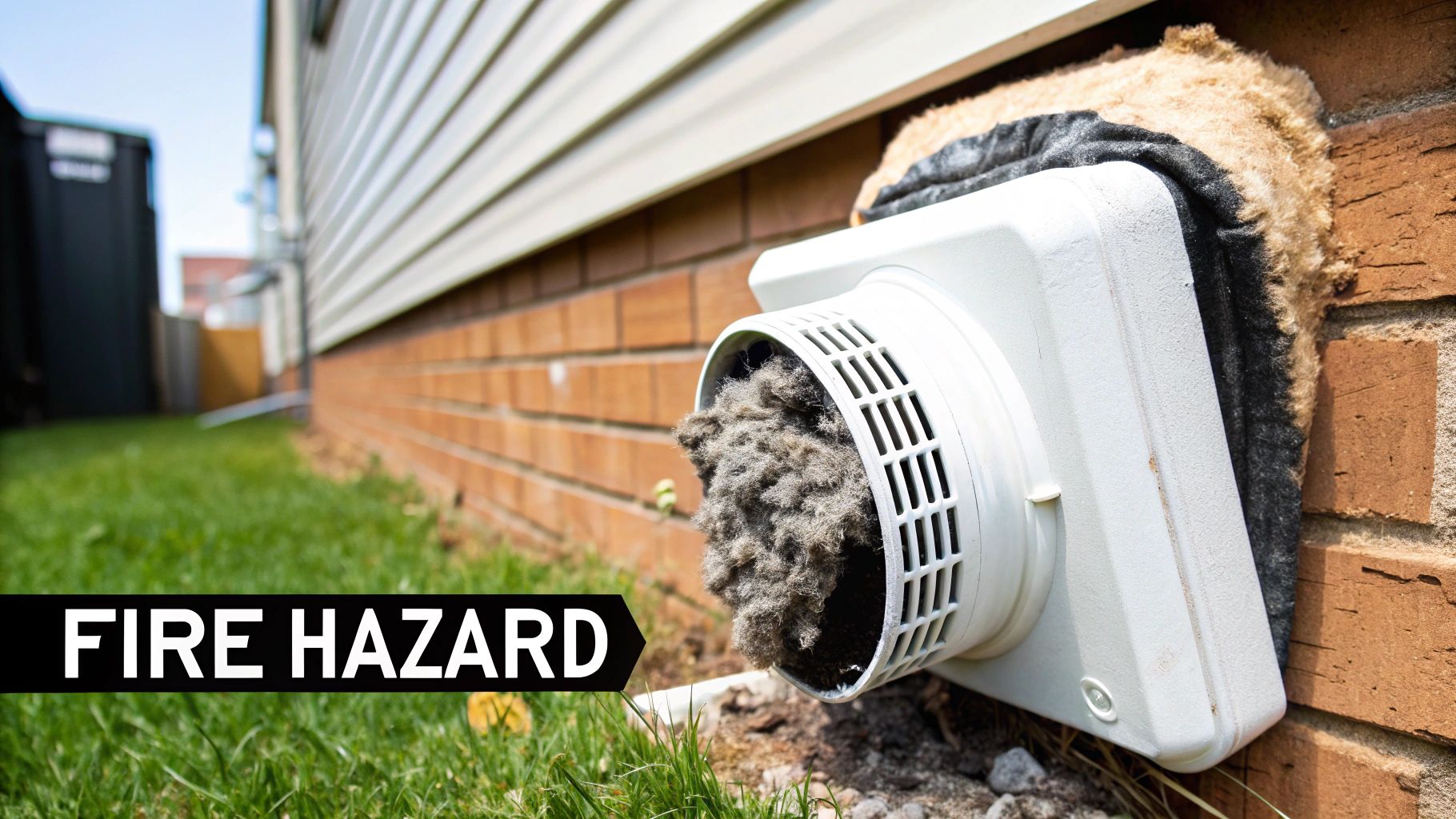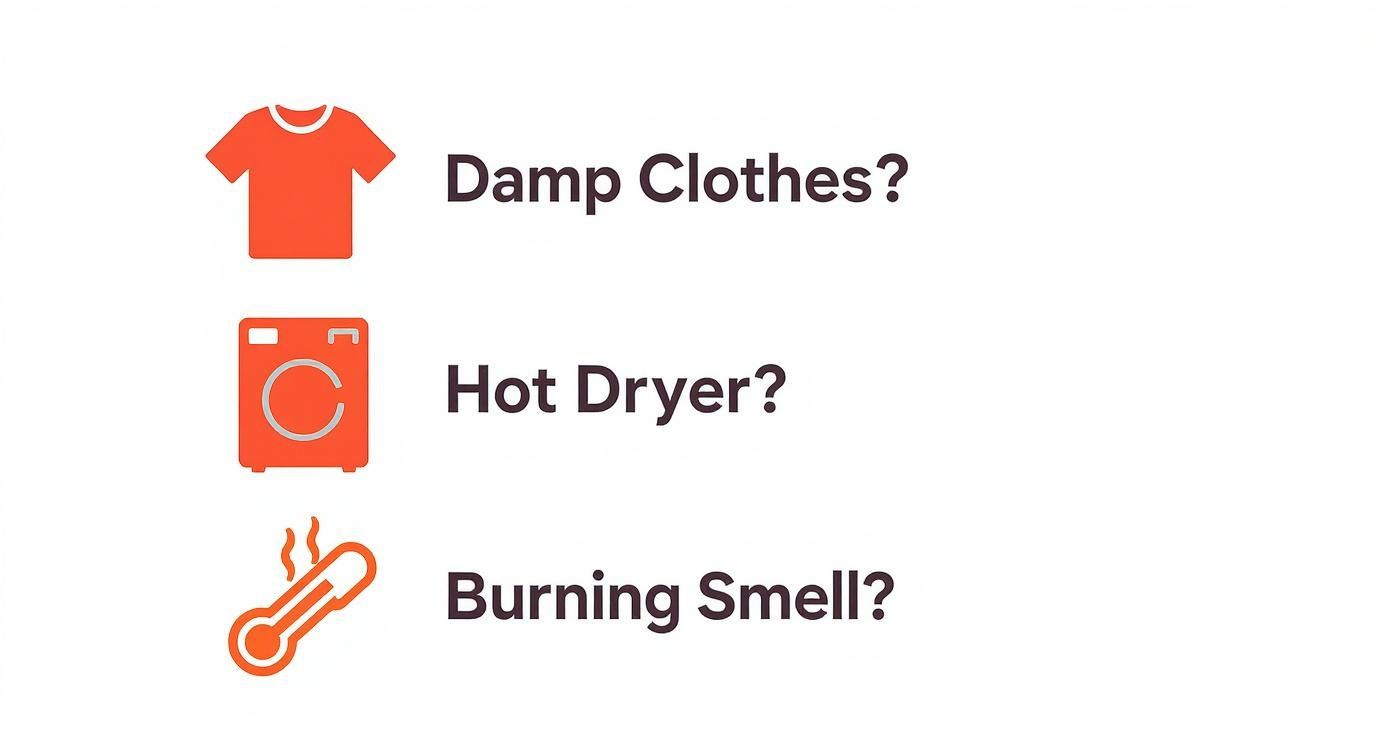Is Dryer Vent Cleaning Necessary? An Essential Guide
- shawnpurifiedair
- Oct 22
- 10 min read
So, is getting your dryer vent cleaned really necessary? Let me put it this way: absolutely, positively, yes. This isn't just another chore you can push to the bottom of your to-do list. Neglecting it is a gamble with your home's safety and your wallet.
Why Dryer Vent Cleaning Is Absolutely Necessary

Think of your dryer vent as the lungs of your laundry room. Its one job is to breathe out all that hot, damp, lint-filled air. But when that pathway gets choked with flammable lint, you’ve got a serious bottleneck on your hands.
The whole system is forced to work harder, leading to problems that are much bigger than just damp clothes. For anyone managing a property, keeping that vent clear is a non-negotiable part of any ultimate rental property maintenance checklist for a reason: it’s all about safety.
A clogged vent doesn't just strain your dryer and inflate your energy bills; it creates a genuine fire hazard. Regular cleaning is one of the smartest, simplest ways you can protect your home.
This isn’t just speculation. Lint buildup is one of the leading causes of house fires. According to the U.S. Fire Administration, an estimated 2,900 dryer fires happen each year, and a failure to clean is the top reason in 34% of those cases, causing millions in property damage. You can dig deeper into the key dryer vent cleaning benefits over on our blog.
To really understand why this is such a critical task, it helps to see the direct consequences of a clogged vent.
Why Dryer Vent Cleaning Is a Necessity Not a Choice
Reason | Impact of a Clogged Vent |
|---|---|
Fire Prevention | Highly flammable lint accumulates, creating a perfect storm for a fire to start inside your walls. |
Energy Savings | Your dryer has to run longer and harder to dry clothes, sending your utility bills soaring. |
Appliance Longevity | The constant strain and overheating leads to premature breakdowns and expensive repair calls. |
At the end of the day, a clean dryer vent means you're not just doing a chore; you're actively protecting your home, saving money, and keeping your appliances running smoothly for years to come.
The Hidden Dangers Inside Your Dryer Vent

That little bit of fuzz you pull from the lint trap is just the tip of the iceberg. The real trouble brews where you can't see it: deep inside your dryer vent. With every single load of laundry, more and more lint accumulates, silently building up into a serious fire hazard.
So, why is this a big deal? Lint is incredibly flammable. As it packs the ductwork tighter and tighter, it traps the hot, moist air your dryer is designed to push outside. This creates a perfect storm: intense heat from the dryer's element meets a ready-made fuel source. That’s all it takes to ignite a devastating fire that can spread through your walls in minutes. Understanding what a fire risk assessment entails can give you a better grasp of how professionals identify these kinds of hidden threats.
A clogged dryer vent creates a perfect environment for a fire to start and spread. The trapped heat acts like an incubator, turning easily ignited lint into a hidden threat that can endanger your entire home.
This isn't just a minor concern; it's a major reason the dryer vent cleaning industry is booming. The global market is already valued at $2.5 billion, with North America making up over 20% of that figure. Homeowners are waking up to the risks, and the market is projected to nearly double, hitting $4.8 billion by 2033. This growth is fueled by a growing awareness of just how preventable these dangers are.
More Than Just a Fire Risk
While fire is undoubtedly the most terrifying outcome, a clogged dryer vent poses other serious threats to your family's health and home. These issues can develop quietly, often going unnoticed until they become significant problems. Keeping your entire home safe means looking at the big picture, which is why we put together this essential home fire safety checklist to help you protect your family from multiple risks.
Here are a couple of other dangers to watch out for:
Carbon Monoxide Poisoning: If you have a gas dryer, a blocked vent is especially dangerous. Instead of venting safely outside, deadly and odorless carbon monoxide gas can back up and seep into your living space.
Mold and Mildew Growth: All that trapped moisture creates a dark, damp breeding ground for mold and mildew. These spores can then get circulated back into your home's air, tanking your air quality and triggering nasty allergies or respiratory issues.
How a Clogged Vent Secretly Drains Your Wallet

Beyond the very real safety hazards, a neglected dryer vent has a direct, and often surprising, impact on your household budget. When lint builds up and blocks airflow, your dryer is forced to work much harder and run longer just to do its job. This inefficiency isn't just a minor annoyance; it’s a hidden tax on your energy bill.
Think about it. Your typical 45-minute drying cycle suddenly stretches into a 70-minute marathon. That extra runtime translates directly into wasted electricity or gas, causing a noticeable spike in your monthly utility costs. Over the course of a year, that wasted energy can really add up.
The Cost of Wear and Tear
This constant strain doesn't just hurt your wallet in the short term, it also puts a tremendous amount of stress on your appliance. Key components like the heating element and motor are pushed to their limits, cycle after frustrating cycle. This relentless overwork is a primary cause of premature breakdowns.
Suddenly, you’re not just dealing with damp clothes. You're facing an expensive repair bill or, even worse, the need for a full replacement that can cost hundreds of dollars. This is why understanding the **average cost of dryer vent cleaning** is so important; it's a small investment that prevents much larger expenses down the road.
Regular dryer vent cleaning isn't a cost; it's an investment. The money you save on lower energy bills and avoided repairs often pays for the service itself, all while protecting your home.
The connection between clean vents and savings is crystal clear. Studies have shown that a clogged vent can increase your dryer's energy use by approximately 10% simply because it has to run so much longer. That inefficiency also causes the machine to overheat, which is a leading contributor to early mechanical failure.
Ultimately, keeping your vent clear is a proactive step that extends your dryer's life, lowers your bills, and prevents the financial headache of an unexpected appliance meltdown. When you look at the numbers, the answer to "is dryer vent cleaning necessary?" becomes obvious.
Telltale Signs Your Dryer Vent Is Clogged
It’s easy to forget about your dryer vent, but your appliance has ways of letting you know when trouble is brewing. Catching these signals early is the best way to head off bigger, more dangerous problems down the road. If you notice any of these issues, it’s a good sign that restricted airflow is putting your dryer under serious strain.
One of the most obvious red flags? Your clothes are still damp after a full cycle. When all that hot, moist air has nowhere to go, it gets trapped in the drum, making it impossible for your laundry to dry properly. You might also notice the dryer itself is unusually hot to the touch during or after a cycle; that’s a direct result of heat backing up into the machine instead of escaping outside.
A burning smell in your laundry room is the most urgent warning sign you can get. This odor often means that lint trapped in the vent is getting hot enough to scorch or even ignite, creating a serious and immediate fire risk.
Observable Clues Inside and Out
Beyond how your dryer is performing, there are physical signs you can look for. Take a moment to check what’s happening in your laundry room and around the exterior vent opening. These clues can quickly confirm a blockage. For a complete rundown, take a look at our guide covering the top **seven clogged dryer vent symptoms** you should be watching for.
You can often spot other issues just by looking at the vent system itself:
Excessive Lint Buildup: You might see fuzzy piles of lint gathering behind your dryer or caked around the outdoor vent flap.
A Faulty Vent Flap: That little flap on the exterior vent hood needs to open freely when the dryer is running. If it’s stuck shut or barely opens, it’s a clear sign that air isn't getting out.
All these symptoms point to the same culprit: a dangerous buildup of lint that needs to be dealt with right away. Once you see the evidence for yourself, the question of "is dryer vent cleaning necessary?" becomes incredibly simple to answer.
Choosing Between Professional and DIY Cleaning
So, you know your dryer vent needs a good cleaning. Now comes the big question: should you roll up your sleeves and do it yourself, or is it time to call in a professional? There’s no single right answer, and the best path forward really boils down to your comfort level with home projects, your budget, and just how complicated your vent setup is.
Going the DIY route can definitely save you some money upfront. You can pick up a specialized vent cleaning kit, usually a flexible rod with a brush on the end, and knock out a decent amount of lint on your own. But be warned, it’s not without its risks. Dryer ductwork can be surprisingly fragile, and it’s easy to accidentally damage it or, worse, fail to clean the entire line. This is especially true if you have a long vent run or one with a lot of twists and turns, which can leave a hidden blockage and a false sense of security.
This infographic gives you a quick visual checklist for the most common red flags that your vent is dangerously clogged.

As you can see, things like damp clothes after a full cycle, a dryer that’s hot to the touch, or any kind of burning smell are all clear signs of a serious airflow problem that needs immediate attention.
The Professional Advantage
This is where hiring a professional really shines. A pro doesn’t just show up with a brush kit from the hardware store; they bring specialized, powerful equipment to the fight. Think high-powered vacuums and spinning rotary brushes that scrub every inch of the vent from the inside out, guaranteeing a level of clean that DIY kits just can't replicate. This is a game-changer for those tricky vent systems that run through an attic, up to the roof, or have a long, winding path.
To help you weigh your options, here’s a straightforward comparison:
DIY vs Professional Dryer Vent Cleaning
Factor | DIY Cleaning | Professional Service |
|---|---|---|
Cost | Lower upfront cost (price of a kit). | Higher initial investment, but can prevent costly repairs. |
Effectiveness | Good for basic, routine maintenance on short, straight vents. | Deep, thorough cleaning for all vent types, including complex runs. |
Tools | Basic brush-and-rod kits. | High-powered vacuums, compressed air tools, and rotary brushes. |
Time & Effort | Requires your own time, effort, and cleanup. | Completely hands-off for the homeowner. |
Risk | Potential to damage the ductwork or leave blockages behind. | Performed by trained technicians, minimizing risk and ensuring safety. |
Best For | Handy homeowners with short, easily accessible vents. | Long or complex vents, first-time cleanings, or peace of mind. |
Ultimately, while doing it yourself can seem appealing, a professional cleaning is often the smarter long-term investment.
While a professional service costs more upfront, it provides peace of mind that the job is done correctly and safely, completely removing the fire hazard and restoring your dryer's efficiency.
If you're still leaning toward the DIY approach and want to make sure you do it right, our complete DIY cleaning guide offers a detailed walkthrough. Weighing the cost against the huge benefits of a truly comprehensive cleaning will help you make the best call for your home's safety and your dryer's performance.
Common Questions About Dryer Vent Maintenance
Even after understanding all the risks, it's natural to still have a few questions about keeping your dryer vent in top shape. Let's clear up some of the most common ones so you can feel confident tackling this crucial home maintenance task.
Getting straight answers is the best way to turn knowledge into action.
How Often Should I Clean My Dryer Vent?
For the average household, a professional cleaning once a year is the sweet spot. It's the best practice to keep things running safely and efficiently.
However, life isn't always average. You might need to bump that up to every six months if you're dealing with:
A large family that keeps the dryer running constantly.
Pets that shed a lot, since all that fur loves to mix with lint and create clogs faster than you'd think.
A long or complex vent with a lot of twists and turns where lint can easily get trapped.
Is the Lint Trap Enough?
Absolutely not. Cleaning your lint trap after every load is a fantastic habit, but it's only the first line of defense. That little screen is designed to catch the bulk of the lint, but it's far from perfect.
Think about it this way: the lint trap only catches about 75% of the lint from your clothes. The other 25% sails right past it and into your vent system, slowly building up day after day.
That hidden buildup is precisely why you can't just rely on the lint trap alone.
Can I Use a Leaf Blower to Clean the Vent?
This is a popular DIY "hack" that we see all the time, but it's a terrible, and dangerous, idea. Please don't do it.
Forcing a blast of high-pressure air into your duct doesn't really clean it out. Instead, it can pack the lint down into a dense, rock-hard blockage that's even harder to remove. Worse, you could accidentally blow apart the vent connections hidden inside your walls. If that happens, you'll be venting hot, moist, lint-filled air directly into your wall cavities, creating a serious fire hazard and a perfect breeding ground for mold.
Always stick to tools designed specifically for the job.
What Does a Professional Cleaning Cost?
You can typically expect a professional dryer vent cleaning to cost somewhere between $100 and $200. The final price will vary based on where you live, the length and complexity of your vent, and just how bad the clog is.
While it's an extra expense, view it as a small investment. You're not just paying for a service; you're buying peace of mind, lower energy bills, and critical protection against a house fire.
A clean dryer vent is one of the pillars of a safe, efficient home. At Purified Air Duct Cleaning, our certified technicians use specialized equipment to get rid of that dangerous lint buildup for good, protecting your family and property. Schedule your professional cleaning today and breathe a little easier.
